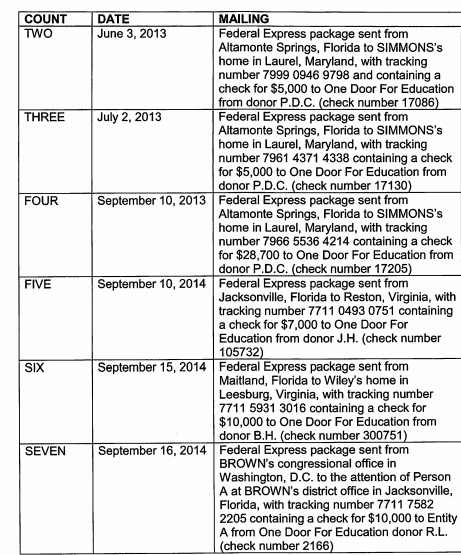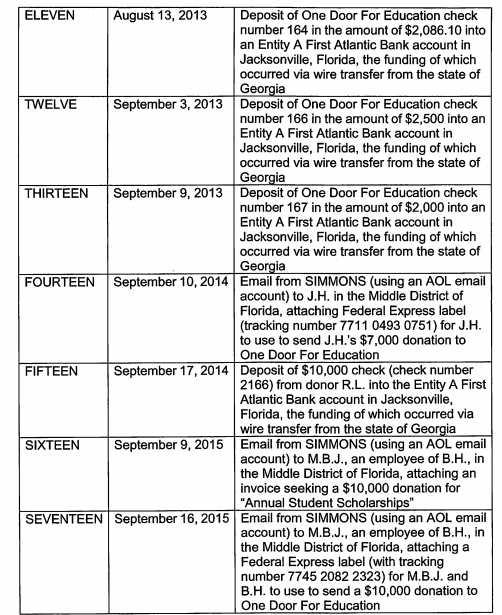
Former U.S. Rep. Corrine Brown faced myriad federal counts related to conspiracy to defraud via what prosecutors call a fake charity: “One Door for Education.” Those charges include conspiracy to commit and aiding and abetting wire and mail fraud, and multiple counts of fraudulent filing of federal tax returns.
FloridaPolitics.com delivered deep-dive coverage of the entire trial: jury selection; opening statements; the government’s case, including exhibits and witnesses; the defense testimony, which mostly comprised of Corrine Brown on the stand; closing arguments; jury deliberation; the final verdict; and everything else that matters.
____
After deliberation started Monday and spilled over into Thursday afternoon, a jury returned a unanimous verdict in the case of former United States Congresswoman Corrine Brown.
With 22 complex counts, it was inevitable that deliberation would take hours, if not days. It took three full days for the jury to resolve the multiple issues related to tax fraud, wire fraud, mail fraud, and conspiracy in what was the political trial of the century in Northeast Florida.
Brown was found guilty on 18 total counts, which sets her up potentially for a prison sentence of over 300 years, and fines and restitution in the millions of dollars.
On Count 1 — conspiracy to commit mail and wire fraud — the jury ruled that Brown was found guilty of mail and wire fraud both.
Counts 2 through 17 involved mail fraud and wire fraud. Counts 2 through 8 — mail fraud — come down to shipments of checks via FedEx; counts 9 through 17 — wire fraud — involve interstate wire transfers, emails, et al.
Graphics detailing these counts can be found below.
Counts 2 through 8 saw Ronnie Simmons and Carla Wiley at the other end of the mail solicited from donors, with the biggest pitch being for a check upward of $28,000 from a single donor.
The jury ruled that Brown was guilty on five of the seven counts: 2, 4, 6, 7, 8.
On Counts 3 and 5, Brown was not found guilty.
Counts 9 through 17 saw Simmons soliciting checks from donors on some, with some “pass-through” transactions reflected in some counts, through the Alexander Agency — the agency of former Brown part-time employee Von Alexander.
The jury ruled that Brown was guilty on seven of the nine counts: 9, 10, 11, 12, 13, 15, 17.
She escaped a guilty verdict on Counts 14 and 16.
On Count 19 — scheme to conceal material facts on Congressional financial disclosure forms — the jury ruled that Brown was guilty.
Count 20 — scheme to conceal material facts — was predicated on “underreporting income” and “bogus” charitable deductions. The jury ruled that Brown was guilty.
Counts 21 to 24: four tax counts. 21 is to “obstruct and impede the due administration of Internal Revenue laws”, with false tax returns from 2012 to 2014 constituting the final three tax counts. Brown was found guilty on all.
Brown will not be imprisoned immediately, Judge Timothy Corrigan said. A sentencing hearing will be months down the road.
Brown exited the courthouse before 3 p.m., looking shaken as she was walked to a black Mercedes, pushing through a phalanx of cameras and mikes like Moses parting the Red Sea.
But there were no miracles for Brown. Only a helicopter overhead and a half-dozen supporters yelling “We love you, Corrine, no matter what!”
Brown’s lawyer, James Smith, said this is just part 1 of the process. While Brown “respects the verdict,” he will file a motion for a new trial.
Smith wouldn’t comment on the jury or the venue — two potentially dispositive factors in this case.
And, with no light in his eyes whatsoever, the Orlando lawyer said that “it may seem like the end of the game, but it’s really the first quarter.”
____
Here’s what jurors considered:
By the numbers: The government claims that over $800,000 was raised from defrauded, duped donors. Of that, $330,000 of One Door money went to Corrine Brown events. And $141,000 of shady cash deposits coursed into her checking account from pass-through sources from 2009 to 2015.
Cash me outside: The government’s case is predicated on donor testimony, which boils down to Brown obliquely pitching the charity as a way to give to her, for reluctant Republican donors who wanted to give outside of normal campaign finance. They sought access; they got it.
But were donors actually defrauded? The defense has asserted that no promises were made saying that all donor money would go to scholarships for underprivileged children. And that Brown delivered on some charity — both directly and indirectly (via rainmaking) at these events.
Born to roll: With friends like Corrine Brown had, who needed enemies? Old staffers, ranging from former co-defendant and chief of staff Ronnie Simmons to former Jacksonville staffer Von Alexander, contend that Brown orchestrated cash deposits from One Door into her own account. Brown denies this.
Conspiracy theory: Brown’s take? “They’re trying to destroy my life!” Brown contends that staffers handled her finances, and handled her taxes and the Congressional financial disclosure forms — thus giving her plausible deniability when it comes to not knowing why hundreds of thousands of dollars of shady pass-through money funded a lifestyle that often cost $10,000 more in a given month than Brown made.
Reasonable doubt: Can Brown convince one juror that she is not provably guilty? Can she do that on all 22 counts she faces? Brown’s defense has been predicated on the emotional appeal, with her saying, over and over again, that she would never have taken money from the scholarship fund for her own expenses. She’s pinned the blame on Ronnie Simmons. Will jurors buy it?
____
The counts:
Count 1: conspiracy to commit mail and wire fraud.
Counts 2 through 17: mail fraud and wire fraud. Counts 2 through 8 — mail fraud — come down to shipments of checks via FedEx; counts 9 through 17 — wire fraud — involve interstate wire transfers, emails, et al. Graphics detailing these counts can be found at the bottom of this piece.
Counts 2 through 8 saw Ronnie Simmons and Carla Wiley at the other end of the mail solicited from donors, with the biggest pitch being for a check upward of $28,000 from a single donor; Counts 9 through 17 saw Simmons soliciting checks from donors on some, with a number of “pass-through” transactions reflected in some counts, through the Alexander Agency — the agency of former Brown part-time employee Von Alexander.
In the cases of Alexander and Simmons, the alleged co-conspirators have asserted they did their deeds at Brown’s behest, and they felt they “couldn’t say no” — thus constituting a conspiracy, in the government’s argument, with Brown atop.
Count 19: scheme to conceal material facts on Congressional financial disclosure forms — which failed to reflect Brown’s “extra income” from One Door and other pass-through sources.
Count 20: scheme to conceal material facts on tax forms — predicated on “underreporting income” and “bogus” charitable deductions to various Jacksonville nonprofits. The donation inflation was big: over $27,000 a year between 2009 and 2015 (off $6,600 a year of actual, provable charity).
Counts 21 to 24: four tax counts. 21 is to “obstruct and impede the due administration of Internal Revenue laws,” with false tax returns from 2012 to 2014 constituting the final three tax counts.
___
What’s next: Jury deliberation continues.








5 comments
Greg E
April 25, 2017 at 11:53 am
This is a great line: “unencumbered by knowledge or bias, they made the cut for further questioning after lunch break.”
Kenny
May 4, 2017 at 1:47 pm
“Despite her unfitness otherwise, Batie called Brown an “expert” on complicated Congressional issues, capable of multitasking.”
She’s not even an expert on using the English language, her “native” language, and something relating to her degree from UF.
If she was that bloody feeble, why in the world was she allowed to continue “serving?”
She’s an embarrassment to the city and state she “represented,” and I use the term loosely, as she only seems to represent herself. Her district is still mostly poor, while she shops in high end department stores. The abuse of power is sickening, for a public servant.
zipgator
May 6, 2017 at 1:46 pm
Great use of language!
Brown, in a muted voice, confirmed that was the case – what fire she might have had Thursday was apparently dampened by Thursday’s torrential rains.
Brown, sounding like a chastened senior citizen much more than someone who was the most powerful Congressional Democrat from this area since Charlie Bennett, was in Grandma Corrine mode throughout much – but not all!
– of this line of questioning.I don’t have my scheduler anymore, so I don’t know why I was there,” Brown said, as part of rambling about events that rivaled Faulknerian stream of consciousness.
Diane
May 10, 2017 at 7:17 pm
If I fail to sign my taxes and allow someone else to sign them, does that free me from the responsibility of their content? I don’t think so and CB should be treated the way every other taxpayer is for the contents of her returns. Year after year of returns are filled with fraud and she should be held accountable.
Diane
May 11, 2017 at 4:15 pm
Thank you, Mr Gancarski, for your coverage of this entire trial. Your posts were laid out in a manner I was able to follow and understand. This has been a sad ordeal for our city.
Comments are closed.